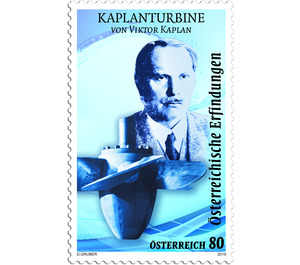Austrian inventions - Austria / II. Republic of Austria 2019 - 80 Euro Cent
Theme: Science
| Country | Austria / II. Republic of Austria |
| Issue Date | 2019 |
| Face Value | 80.00 |
| Color | grey blue |
| Printing Type | offset |
| Stamp Type | Commemorative |
| Item Type | Stamp |
| SID | 156977 |
| Dimensions | 32.00 x 50.00 |
| In 94 Wishlists | |
A special stamp from the series “Austrian inventions” is being dedicated to Viktor Kaplan, one of the most important inventors of the 20th century. His modified water turbine revolutionised the use of hydropower. Viktor Kaplan was born in Mürzzuschlag, Styria, in 1876. Even as a child he demonstrated a real talent for technology and consequently went on to study mechanical engineering at the Technical University in Vienna. In 1903 he took up his post as a designer at the German Technical University in Brno – at that time one of the centres of mechanical engineering for Austria – where he qualified as a lecturer and was subsequently awarded a professorship in 1918. He spent almost 30 years teaching and conducting research there, and it was also at this university that he produced his most important invention, the Kaplan turbine, in 1913. Following a serious illness, Kaplan was pensioned off in 1931 and returned home to Austria. He died in Unterach am Attersee in 1934, where he is now commemorated by a themed walk. Deriving energy from water power: Kaplan’s particular field of interest was hydropower. He developed the standard water turbines of the day further by reducing the number of blades to four and positioning them adjustably on the impeller. This minimised friction losses and meant the turbine could be adjusted to the water flow rate. This modification enabled the turbines to be used even when the water volume was variable, such as during the meltwater period in spring. However, it was some time before Kaplan’s new invention caught on. Battles with competitors, patent disputes and the outbreak of the First World War all delayed implementation. The first Kaplan turbine was put into operation in a knitting wool factory in Lower Austria in 1919 and remained in operation until 1955. Today it is on display in the Technical Museum in Vienna. Thousands of Kaplan turbines are in use around the world, producing around ten per cent of the world's hydroelectric power. What is more, they play a particularly important role in run-of-the-river power plants. Their construction makes them especially well suited to low drop heights and large quantities of water, thus making them suitable for use on the Danube, for example, which has nine run-of-the-river power stations using Kaplan turbines.


